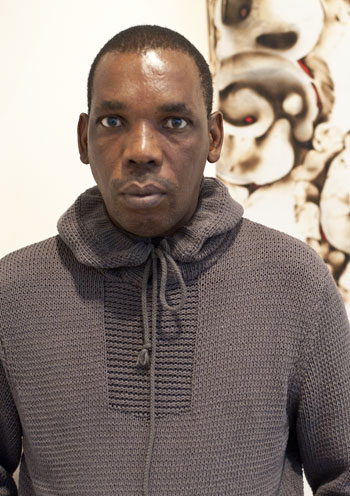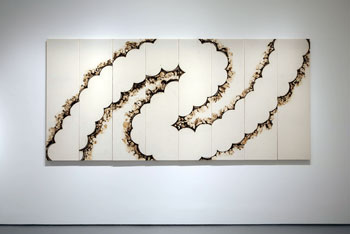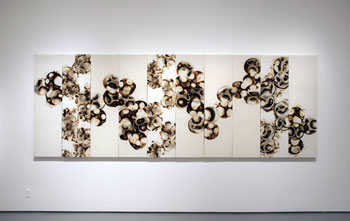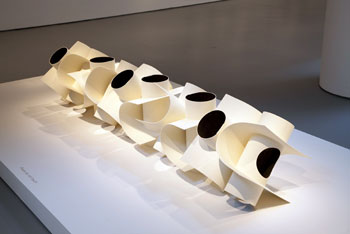
|
|
Sandile Zulu
b. 1960, South Africa
Born in Ixopo, Kwazulu-Natal, Sandile Zulu came of age during a time when he routinely experienced the unequal access to land, education and resources that defined the apartheid era in South Africa. An awareness of these inequities and the tensions between exclusion and inclusion, history and the present, continue to inflect his work. Yet, he is motivated by a combination of the creative imagination and a philosophical outlook that motivates his visual explorations of the interconnectedness of all things--cells, bodies, plants and planets; art, science and philosophy.
Zulu began his formal arts education in 1982 at the competitive Rorke's Drift Art and Craft Centre, which afforded talented black South Africans with access to art materials and training. It closed after his first year, at which time he was among a select few black students permitted entrance to the Technikon Natal in Durban. In 1993 he received his degree from the prestigious University of Witswatersrand in Johannesburg. It was at Witswatersrand that Zulu began his first experiments with fire. His first solo show, Fire!, took place a mere two years later at the Rembrandt van Rijn Gallery in Johannesburg. For that landmark exhibition, Laurent Devèze wrote, "There is the tenacity of the explorer in this young artist's work, always exploring further and further. Following with extreme caution the biting of the flame on the cardboard, Sandile makes incredible discoveries; what turns the burning into a track, and what makes the consumed become an incandescence." Nearly 16 years later, Zulu's explorations with fire have been exhibited across South Africa, Europe and in New York City. The National Museum of African Art is honored to bring Zulu to Washington D.C. for the first time and join his extraordinary vision with that of Henrique Oliveira of Brazil.
|

Photograph by Franko Khoury, National Museum of African Art
|

Large Colon (y) Brownprint--a histopathological case
2010
Fire, water, air, earth, canvas
Collection of the artist
Photograph by Franko Khoury, National Museum of African Art
Sandile Zulu plays with medical references while exploring political, historical and visual themes in Large Colon (y) Brownprint--a histopathological case. Histopathology is the study of the microscopic structures of diseased tissues. In this work, Zulu has carefully controlled fire to create forms that resemble magnified cellular structures. In so doing, he reveals their similarity to larger forms in the body, such as the coils of the colon. Unlike Oliveira's Xilonoma Chamusquius, in which the bulging twists and turns of diseased intestines take on a fantastical appearance, Zulu's anatomical reference becomes graceful, like an arabesque.
Large Colon (y) Brownprint--a histopathological case is a striking two-dimensional or flat work. Each of its eight panels takes on the appearance of a slide beneath the microscope. In some areas, Zulu's trademark flames have burned through the surface of the canvas to reveal the wall behind. As he says, "I want my work to interact with its background. It is to transcend the wall on which it is hung."
|

Old Bones, Old Genes--a population groups case
2010
Fire, water, air, earth, canvas
Collection of the artist
Photograph by Franko Khoury, National Museum of African Art
For Sandile Zulu, all aspects of art and life are interconnected. Bones and genetic matter are the materials by which humans of the past, present and future are made. From these skeletal structures and genetic codes, human creativity, science and all knowledge have come into being. For some, this knowledge has yielded power and prosperity; for others, colonization, marginalization and deprivation. It is all interconnected. This expansive philosophy is at the core of each work of art by Sandile Zulu.
In Old Bones, Old Genes, Zulu has crafted a work composed of 10 canvases. This modular approach echoes the modular building blocks of genetic codes and cellular structures, as well as the systematic approach of the Dewey Decimal System and other techniques for ordering the vast world of knowledge. On the surface of these panels, he has burned circular patterns that simultaneously evoke strands of DNA, microscopic views of cells and telescopic views of planets and heavenly bodies.
|

Spinal Diagnosis--a regenerate case no. 1
2010
Fire, water, air, earth
Collection of the artist
Photograph by Franko Khoury, National Museum of African Art
For each of his works of art Zulu lists fire, water, air and earth as his materials. Fire provides light and serves as a symbol of knowledge. It is also a medium of revolution, destruction and creativity. Because of fire, we have cooked food to nourish our bodies and minds. The inclusion of the three complementary elements within Zulu's list of materials illustrates the artist's holistic approach to his work, though water, earth and air play less visible roles as they are not necessarily applied to his canvases. Zulu uses water in a personal ritual to cleanse his hands or sprinkle around his space before he begins to work. Likewise, he might sprinkle dust in the air as part of a tribute to the earth. Air, in turn, fuels his fire and gives him breath.
Spinal Diagnosis--a regenerate case no. 1 reveals the artist's sophisticated explorations of both two-and three-dimensional space. Each wedge evokes a spinal disk. Although the artist has worked with barbed wire, grasses and PVC piping in the past, here he has kept the surface smooth. As he states, "The association between the elements and the surfaces, or the material with which I am working, is very important. I choose it. Like canvas, it works very well with fire and helps to accentuate its symbolic effect."
|

Spinal Diagnosis--a regenerate case no. 2
2010
Fire, water, air earth, Flexi plywood
Collection of the artist
Photograph by Franko Khoury, National Museum of African Art
As suggested by the title, this floor installation is conceptually linked to Spinal Diagnosis--a regenerate case no. 1, the three-dimensional painting on the back wall. The artist explores the unifying structure of the backbone as a metaphor for political, social and mental stability in the wall piece. The spine is conceived as healthy and enclosed. By contrast, the spine in Spinal Diagnosis--a regenerate case no. 2 has been laid bare. Whether this is the result of treatment or trauma, we do not know.
The distinctive material in this tautly designed installation is Flexi plywood--the bendable board Henrique Oliveira uses in his installations. As part of the visual dialogue between these two artists, each experimented with the materials of the other: Oliveira with fire in Xilonoma Chamusquius, and Zulu with Flexi plywood.
|
|
|
|